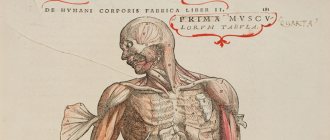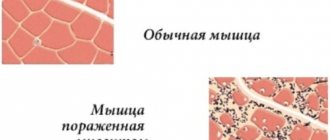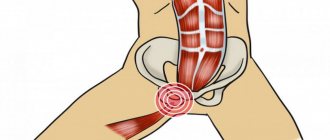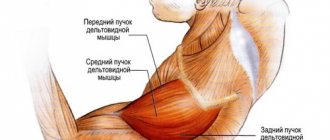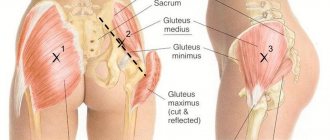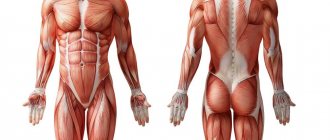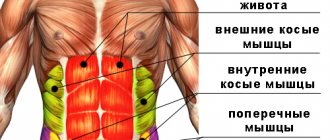Location and main functions of the back muscles.
We have already found out that good development of the back muscles is very important. Now let's look at what muscles these are, where they are located and what functions they perform.
Conventionally, the back can be divided into several zones:
- Scapular. This area is located above the surface of the shoulder blades and attached to the 6th cervical vertebra.
- Subscapular. This area is located under the shoulder blades on both sides of the spine (left and right).
- Vertebrate. It starts from the head and ends in the pelvic area.
- Lumbar . Located in the lumbar region. It is located perpendicular to the spine.
- Sacral . Located above the sacrum. Located parallel to the spinal column.
Anatomy of the back muscles
Also, due to the way these muscles are located, they can be divided into two types:
Superficial
These muscles are very clearly visible, as they are located on the surface. It is for their development that bodybuilders devote the most time, since the result is clearly visible. At one edge they are attached to the long processes of the spine. They resemble small tubercles and can be easily felt in the area of the spine. The other edge is attached to the shoulder girdle, ribs, shoulder blade and pelvis. Depending on which area of the back we are talking about.
Deep muscles
They are also called internal. They are located deep under the superficial muscles. They originate from the skull and end in the area of the coccyx. They are attached to the short processes of the spine, thereby forming a muscular corset, from the head to the sacrum, which envelops the spine on all sides. They are mainly included in the group of spinal straighteners. Therefore, they are very important when working with heavy weights. Their good development also affects the appearance of the back.
Treatment
Treatment of pain in the trapezius muscle is, first of all, the use of manual techniques, including massage of the trapezius muscle. However, according to recent research, manual techniques only affect shortened muscles, which reduces pain, but does not eliminate the root cause of the disease. Over time, the pain appears again.
The mechanism responsible for the development of pronounced clinical manifestations of the disease is complex and multifactorial, therefore it is necessary to influence the disease from all sides.
When treating pain in the trapezius muscle, psycho-emotional correction should be carried out simultaneously, since in 85% of diseases myalgia is accompanied by a depressive state.
This could be aromatherapy, autogenic training, breathing techniques. Correction of vascular pathologies of the brain is carried out with nootropics and amino acids. Then manual therapy, acupuncture and massage for the trapezius muscle are prescribed. The patient should perform relaxation exercises himself in his free time.
To treat myofascial syndrome, it must destroy the pathological overtension in the trigger. The patient should avoid postures that provoke overload; the use of corsets to correct posture is recommended. If the pain is severe, lidocaine or other injectable painkillers are prescribed. According to indications, drug treatment with myelorelaxants is prescribed.
The effectiveness of the therapy depends on the earliest possible contact with a doctor and how responsibly the person treats the treatment.
Vessels
Arteries of the Head and Neck: Anatomy, Diagram, Atherosclerosis
Feb 06, 2020 Kokh V. A.
16497
Vessels
Aberrant Subclavian Artery And Its Branches, Groove: Anatomy, Scheme, Segments
Feb 06, 2020 Kokh V. A.
6452
Vessels
Superficial muscles
These include the largest muscles and many exercises in the gym are aimed at developing them.
Trapezoid
This is a large flat muscle located on the surface of the back. It has two halves of a triangular shape, and when folded together they create a trapezoid. It covers almost the entire upper back. It starts from the back of the neck and attaches to the shoulder blades and collarbone. Conventionally, it can be divided into three parts.
- Upper. It is located in the scapular part of the back. One edge is attached to the occipital bone and all cervical vertebrae. The other edge attaches to the outside of the collarbone.
- Average. Also located in the area of the scapular region, under the upper part. It originates from the thoracic vertebrae from the 1st to the 4th. Next, attach to the lateral (upper) edge of the scapula.
- Bottom. It is located in the subscapular region. Attached to the long processes of the thoracic vertebrae, from the 5th to the 12th. And the other edge to the medial end of the scapula. Or rather, to the tubercle located on it.
You can learn about methods of training the trapezius from the article: The best exercises for the trapezius
Functions:
Working in two halves brings the shoulder blades closer to the spine. The upper part is involved in stabilizing the neck and helping to tilt it back. This part also raises. Shoulder blades up. And the lower part lowers it. This results in the raising, lowering and rotation of the arms. Straining separately, the left and right parts turn their heads, each in their own direction.
Latissimus muscles
These are the favorite muscles of many bodybuilders. It is on their development that bodybuilders spend all their energy. Many newcomers, when they come to the gym and say that they want to pump up their back, mean these muscles. Their good development makes your back visually larger and gives it a V shape. If you look from the front, you can see how this muscle protrudes in the armpit area. They are located in the lower back. The lats are covered from above by the trapezium and end in the pelvis area. The upper part covers the lower angle of the scapula. Going around this angle, it is attached to the crest of the lesser tubercle of the humerus. And from below it is attached to the long part of the thoracic vertebrae from the 6th to the 12th. Also to all lumbar vertebrae, to the sacrum (lower part of the pelvis) and to the iliac crest (pelvic bones). The other edge is attached to the lower 5 ribs.
Function:
Moves and extends shoulders. When the arms are fixed, the body is pulled towards them (rope climbing, pull-ups). It also fixes the position of the pelvis and torso. Also involved in lateral bending.
Rhomboid major and minor muscles
This muscle is located under the trapezius, but is also superficial. It connects the shoulder blades to the spine and to each other. The large rhomboid is attached to the 1st to 5th thoracic vertebrae, with the other edge to the lower part of the scapula. And the small one is attached to the 1st to 2nd cervical vertebrae. And the other edge to the top of the same shoulder blade. Although the functions of these muscles are not very numerous, the tasks they perform are important.
Function:
One of the main functions is to stabilize the scapula. If this muscle is weak, the back will take on a stooped appearance. The large rhomboid is involved in the movement of the scapula up, forward and backward. And the small one helps the shoulder blade rotate.
Levator scapulae muscle
It is located under the trapezoid. This is a small muscle, but it is the second most important after the trapezius in terms of contraction frequency. That is, she very often gets involved in the work. Attached at the upper end to the first 4 cervical vertebrae. The lower edge attaches to the inner upper corner of the edge of the scapula, as well as to the middle section.
Function:
Raises the shoulder blade up.
Anatomical structure of the trapezius muscle
From an anatomical point of view, the trapezius muscles consist of three parts:
- upper (located in the neck area);
- middle (located at the top of the shoulder blades);
- lower (located between the shoulder blades and below them).
Top part
The musculature in this area causes movement of the shoulder blades; it rotates them, abducts them toward the spine, raises and lowers them (when shrugging), and also assists in most movements of the neck and head.
Incorrect posture (slouching) can provoke chronic tension in the upper part of this muscle, which leads to various pathologies and painful conditions in the cervical spine (headache, dizziness, chronic pain).
Middle and lower part
The muscles of this zone, together with the rhomboid muscles, ensure the adduction of the scapula to the spine. The rhomboid muscles are located deep, closer to the center of the body compared to the trapezius muscles.
They are also responsible for bringing the shoulder blades together, which is extremely important for stabilizing the body and its correct position.
Function
We have already mentioned the functions of these muscles above. Let us recall once again what they are responsible for:
- I ensure the adduction and abduction of the scapula to the spine;
- raise and lower the shoulder blade up and down;
- allow rotation of the scapula;
- are responsible for bringing the shoulder blades together;
- ensure simultaneous lifting of the shoulder blades;
- the desire to cover their ears is also carried out by them.
Deep back muscles
These muscles are aimed at maintaining the spinal column. They are located under the superficial muscles, so we do not see them. Also, some of them are responsible for posture and supporting the head.
Erector spinae muscle
The erector spinae muscle (transverse spinalis) is the longest and strongest muscle in the back. It runs along the entire length of the spine, from the head to the pelvis. It is constantly under load, as it keeps our back in a straight position. Thanks to this, we can walk on two legs. The muscle originates from the inner (dorsal) surface of the sacrum: the long and short processes of the lower back. It is also attached to the 8-9 ribs (lumbothoracic fascia). And then it reaches to the back of the head. The lower bundles of this muscle strengthen the ribs, thereby creating a strong support for the diaphragm
It can be divided into 3 parts, depending on the place of attachment:
- The iliocostalis muscle is attached to the ribs. It is the lateral part (lateral, further from the axis of the spine).
- Longissimus muscle - attaches to the transverse (long) processes of the lumbar spine. Located in the middle part, closer to the head. Located between the iliacus and brevis muscles.
- Short muscle (spinalis) - attached to the short processes of the spine. Located medially (closer to the axis of the spine).
Functions:
With bilateral muscle contraction, the spine straightens and remains in this position. Tilts the body to the side. Also indirectly involved in breathing and turning the head.
Transverse spinalis muscle
This is the deepest muscle of the back located under the erector spinae. It is impossible to see, but it is one of the most important muscles of the back. It supports the spine, making posture straight and at the same time giving flexibility to the spine. It is located in the depressions between the spinous (short) and transverse (long) processes and runs along the spinal column. The transverse spinalis muscle is divided into three parts according to the number of vertebrae through which it is thrown.
1. Iliac-costal ( semispinalis ) muscle. Its bundles extend across 5 or more vertebrae. This muscle is located more superficial than the others. It is also divided into 3 parts:
- Cervical. Lies between the transverse processes of the 5 upper thoracic and 3-4 lower cervical vertebrae. And the other side is attached to the occipital bone. This muscle is divided into two parts: lateral and medial.
- Chest. Located between the transverse processes of the upper thoracic ribs. And the spinous processes of the 6 lower cervical.
- Lumbar. It is located between the transverse processes of the 6 lower and spinous processes of the 7 upper thoracic vertebrae.
The transverse spinalis muscle is divided into three parts according to the number of vertebrae through which it is thrown.
Functions:
With complete contraction of all bundles, the muscle straightens the spine. Also pulls the head back and can hold it in this position. Also involved in turning the head.
2. Multifidus muscles . Covered by the semispinalis muscles on top, and in the lumbar region they are further muscles. It is located throughout the entire spine between its transverse and spinous processes. They are attached from above to the 2nd cervical vertebra, and from below to the posterior surface of the sacrum. Throw over 2, 3 or 4 vertebrae.
Functions:
When one of the muscles contracts, the body tilts in the same direction. If two muscles contract at once, they straighten the spine. And one of the functions that this muscle performs is to rotate the spine around the vertebral axis.
3. Rotator muscles of the back . They have the deepest location and are transferred to the spinous process of the vertebra, which is located above.
Function:
Participate in turning the back around the axis of the spine.
Belt muscles of the neck and head
These two muscles belong to the muscles of the back and neck. They are located under the upper part of the trapezoid, closer to the head. Working together, they perform a common function, rotating the head and maintaining it in a level position.
Neck muscle
It starts from below and is attached to the spinous processes of the 3rd and 6th upper thoracic vertebrae. Next it goes towards the back of the head and is attached to the posterior tubercles of the transverse processes of the 2nd and 3rd cervical vertebrae.
Functions:
With simultaneous contraction of 2 parts of the muscle at once, it extends the cervical spine. When one muscle contracts, it turns the neck in its direction.
Head muscle
It originates from the back of the head, or rather from the arched bulge in the ear area. Next it goes diagonally and attaches to the spinous process of the 6th cervical vertebra and the 3rd upper thoracic vertebra.
Functions:
When two muscles contract at once, it straightens the cervical spine and tilts the head back. When unilateral, he turns his head in his own direction.
What diseases are the latissimus dorsi muscles susceptible to?
Like any other part of the human body, the latissimus muscle is susceptible to disease and injury.
The most common of them are the following:
- Myalgia (muscle pain). This condition is characterized by pain of varying intensity - from minor discomfort felt after physical activity or being in an uncomfortable position, to pain requiring medical treatment. Most often, myalgia develops as a result of diseases of the spine, in which the spinal column loses the ability to fully perform its supporting function (osteochondrosis, herniated intervertebral discs, spondylosis, scoliosis, etc.). In this case, the back muscles try to compensate for this - they take on part of the supporting function of the spine, which inevitably leads to their overstrain and excessive stretching of the muscle fibers.
- Myositis (inflammation of muscle tissue). The cause of this disease can be a variety of factors - from injuries resulting in muscle infection, to toxic and parasitic lesions (poisoning with drugs, toxic fumes, waste products of viruses, or muscle damage by parasites). With this disease, the muscles are in a constantly tense state, which leads to compression of the blood vessels and nerves running in them. The most dangerous is the chronic course of myositis - as the disease progresses, the pain syndrome can be relieved on its own, which makes a person unreasonably believe in spontaneous recovery and cancel a visit to the doctor. But the pain goes away not because the inflammation has gone away, but because of the gradual necrosis of muscle fibers that have not received enough nutrients and oxygen for a long time.
Very often, back muscle diseases develop as a result of injuries or diseases of the leg joints. Insufficient shock absorption when walking, lameness and other disorders caused by problems in the lower extremities force the spine and muscles to compensate for the load, which leads to their overwork, inflammation and rapid wear. Therefore, if you experience pain in the back muscles that has developed after dislocations, leg fractures, arthritis, etc., you should consult a doctor.
Such a symptom, in combination with a recent injury or disease of the lower extremities, may indicate so-called “compensatory loads” that require treatment not of the back, but of the legs.
Read also…. Medicines for joint health: what are they?
There are also muscles on the back that are involved in breathing by raising and lowering the ribs.
Serratus posterior superior
This muscle is superficial. It is located under the rhomboid muscles. It starts from the ligaments of the 2 lower cervical vertebrae and the 2 upper thoracic vertebrae. It goes down and is attached to the ribs from 2 to 5 ribs. Depending on the training of the muscles, the number of their bundles may vary or be absent altogether.
Functions:
It lifts the ribs to which it is attached, thereby helping to inhale.
Serratus posterior inferior muscle
The muscle is located in the area of transition of the thoracic to lumbar spine. It originates from the 2nd or 1st lower thoracic vertebrae and the 2nd or 3rd upper lumbar vertebrae. It is directed diagonally upward and attached to the 9th to 12th rib.
Functions:
Lowers the ribs, participating in the act of exhalation.
Exercises to develop back muscles
Any muscle group can be developed, and the back muscles are no exception. The best way to cope with this is with special targeted exercises. Of course, for each person the effect of them will be purely individual, so it is worth choosing those that are most useful for you.
There are basic exercises that strain the entire back and isolated ones that target only a specific muscle.
Basic exercises
Deadlift
This is the best exercise for developing the back, as it involves all the muscles (latissimus, trapezius, rhomboid major and minor, splenius muscles of the neck and all the erector spinae muscles). It is a must-do for both beginners and professionals.
Pull-ups on the bar
This exercise is perfect for developing the latissimus dorsi muscles, or rather their width, both the rhomboid major and minor. The muscles of the arms and shoulders will also receive a load, but for us this is not so important now. Also, by changing the grip from narrow to wide, you can change the degree of impact on the back muscles. I advise you to experiment with this and find the optimal grip for you. You can do pull-ups either with your own weight or using weights in the form of pancakes, dumbbells, and weights.
Bent-over barbell or dumbbell row
These two options are also basic, aimed at developing the latissimus dorsi muscles, or rather their thickness. Also, all deep muscles are statically loaded to keep the spine and neck in an even position.
Shrugs with a barbell or dumbbells
This is a specialized exercise for developing the trapezius muscle. Experiment with weights and grips, then you can find the right option for yourself.
Pullovers with dumbbells
Some believe that pullovers are aimed at developing only the pectoral intercostal muscles. But that's not true. The movement itself also involves the latissimus dorsi muscles, and the lower and upper serratus muscles. Therefore, we also include it in our back training.
Isolated exercises
Vertical pull of the upper block
This is a simpler version of pull-ups. It is performed in a special block simulator. You can use different handles, narrow, wide and a handle with a parallel grip. This will also change the area of action on the back muscles and increase or decrease the range of motion. There is also a one-handed option. I work the latissimus dorsi and rhomboid muscles.
Lower pulley to the waist
The lat pull-down is an isolated exercise similar to a bent-over barbell or dumbbell row. Only because of the sitting position, the load is removed from the muscles that straighten the spine. Therefore, only the rhomboids, latissimus muscles and a little trapezius work.
Bent-overs with a barbell
And the last exercise for the back. It is aimed at the lower back, rectifiers and deep muscles of the transverse spinalis.
There are also many different machines available for back training. Many of them will also help you achieve good results. It is possible that in the future they will replace basic exercises. But until this happens, start training from the base, and then experiment and look for those exercises that work for you.
Good luck to everyone in the gym!
Top 4 exercises for the latissimus muscles for the gym and at home
In sports, there are 4 main types of exercises for the latissimus dorsi muscles with dumbbells, barbells and other equipment. Each type has many variations of execution that allow you to change the nature of the load to avoid muscle adaptation. These 4 exercises are fully enough to pump up your lats.
Pull-ups
Ultimate and basic movement for working out the entire group. It is deservedly considered the best exercise for the latissimus dorsi muscles. If you have a weak level of physical fitness, you can perform it with the support of rubber bands (or use lightweight techniques, such as horizontal pull-ups).
Technique:
- Hang from the horizontal bar, holding the handles (or bar) with an overhand grip, slightly wider than shoulder-width apart.
- Begin to pull your body up using your back muscles (at the top point, your arms and shoulders are more involved in the work).
- As soon as your chin crosses the line of the bar, pause and return to the starting position.
- At the lowest point, it is important not to spread your shoulder blades or relax your shoulders, as this can increase the risk of injury.
- Use the grip that allows you to make the movement cleanly and without jerking (with greater development of the biceps, when the triceps becomes a limiting factor, you can master the technique with a reverse grip).
Read more about pull-ups for back muscles →
Bent-over row
It can be used in different variations, but the specificity of the exercise is the same. For variety, you can alternate options:
- Bent-over row with a barbell.
- Alternately with dumbbells with emphasis on the bench..
- Together with dumbbells.
- With rubber band/expander.
- With bottom block.
- In the Smith machine.
- The technique for each exercise will be different, but in all movements it is important to perform the pull using the back , not the arms (the arms only engage when bringing the weight to the body).
- also important to exclude any inertia . Unlike other types of rods, the body must be fixed.
Vertical block thrust
Although this movement is often called a “pull-up replacement,” it is actually incredibly effective. Taking into account the fact that a huge part of athletes (and almost all beginners) cannot do full pull-ups, working with the upper block becomes one of the best among all exercise machines for the latissimus dorsi muscles.
Technique:
- Take the (long) handle with a wide grip and lower yourself onto the seat. The back should be straight, the elbows should be pulled straight to the sides (for the correct position of the shoulder and arm).
- Start pulling the handle towards you without changing the position of your body. The pull is carried out to the upper chest.
- To avoid damaging your nose or face, your head can be pulled back when lowering the handle (no more than 2-3 cm).
- Pause at the bottom and return to the starting position.
Read more about vertical block traction →
Horizontal rods
The peculiarity of these movements for pumping the latissimus dorsi muscles lies in the position of the body. In the lever pull, it is securely fixed and any swinging is excluded - the load will fall on the target muscle. In block deadlifts, on the contrary, it is recommended to swing the body a little, in the range of 10 degrees. This allows for a better stretch of the lats while abducting the handle.
Technique for performing horizontal traction (in a block):
- Sit on the bench and grab the handle so that the cable is taut in the starting position.
- Begin to pull the handle towards your lower abdomen, straightening your shoulders in parallel.
- Pause and return the handle to the starting position (bend your shoulders forward a little to stretch the muscles).
In the exercise, it is important to avoid rocking the body, rounding the back, and pulling with the arms and shoulders.
Exercises for home
In most cases, exercises performed at home for the latissimus dorsi muscles will be a replacement or alternative to movements from the gym:
- Pull-ups - there is nothing to replace them at home; they are performed only with a horizontal bar.
- Horizontal pull-ups – TRX loops, gymnastic rings.
- Vertical traction – in the presence of a horizontal bar and a harness (which will provide tension and the required load).
- Bent-over rows - using dumbbells, a tourniquet, a sandbag, or even a bottle of water or sand (the movement technique does not change).
- Horizontal traction - only with a tourniquet.
These options allow you to completely replace all movements and efficiently work out the lats without losing efficiency.
What about deadlifts?
Separately, it is worth noting the deadlift. This is a technically complex exercise for the latissimus dorsi muscles for men, which is very popular. It is a mistake to use it to load the lats, because the upper back does most of the work. The lats are loaded primarily in the lower part.
